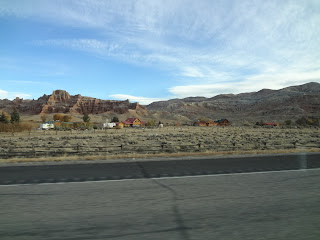The fact that
my Yellowstone season is truly over has sunk in. I look forward to the
drive home. It will be a different route home (I-80 instead of I-90), the chance
to see new territory. Unlike the firm deadline of new employee check-in last
May, my eastbound timetable is carefree. So is the weather forecast which calls
for fair, calm skies the next several days.
The first
day is spent crossing Wyoming on a long diagonal along US 287. The drive down
to Dubois last night from Yellowstone was just a down payment; it takes six
hours to reach I-80 at Rawlins and on to Cheyenne in the state’s southeast
corner.
 |
| Along US 287, east of Dubois |
The
landscape here is stunning! Panoramas composed of rock, cliff, and sagebrush
stretch to the horizons. Trees cease to exist other than a narrow band of
cottonwoods here and there clinging to the edge of a watercourse. This begins
the High Plains of America, a vast expanse of land robbed of moisture by the
Continental Divide lying just to the west.
Here,
elevation matters. It alters the weather and determines the habitat. On the
highway, it strains the engine and reminds you of the importance of good
brakes. We are talking big numbers here. I pass through Lander, a respectably
sized city where the elevation is 5,357 feet. A stone’s throw to the west lies Wind
River Peak, cresting at 13,192 feet.
 |
| Wind River Indian Reservation, north of Fort Washakie |
Already, I
miss the rivers of Yellowstone. Granted, little is revealed about most rivers
from behind the windshield rushing down a highway, yet nothing tempts me to
pull over for a closer view. The first two hours of driving are along the Wind
River, known for some good trout fishing. It must be known for that someplace
else. It isn’t that Wyoming doesn’t have good rivers for trout. The Green River
and Flaming Gorge lie to the southwest; the Bighorn to the northeast. Once on
I-80, I cross over the North Platte, a reminder of some great trout fishing just
to the south. For now, these are marks on my mental map, destinations for
future trips.
 |
| The clouds entertain along I-80 |
It is
sparsely populated, feels desolate. In surface area, Wyoming is equal in size
to Michigan, approximately 98,000 square miles. Yet, just 570,000 people live
here, compared to 9.9 million in Michigan. Without a doubt, it is a very
different lifestyle from my Midwestern sensibilities.
Road Day
One ends 200 miles into Nebraska at Gothenburg. I pitch my tent in the dark at
the KOA Campground there. A town with some history, it lays claim to the
birthplace of the Pony Express. I am up and on the road at sunrise the next
morning, eager to press on.
 |
| Pony Express Mural, Gothenburg Nebraska |
If the
theme of yesterday’s drive was rock, today it’s corn. It is harvest time in the
Great American Breadbasket. Nebraska is a beehive of activity. Combines are in
the table-flat fields everywhere; tractor trailer rigs hauling the bounty to gigantic
grain elevators; long freight trains on the move. The economic powerhouse that
is America’s agriculture is palpable.
After
Nebraska, it’s Iowa. Another 300 miles before this day is to end. More
cornfields here, but these are draped over lovely rolling hills. Trees have
returned to the landscape. Handsome oaks edge the fields, and stand in large
woodlots. There are rivers here, hinted at by the contours of the rolling
countryside. History markers at highway rest stops record their importance to
the nation’s development long ago. Council Bluffs on the Missouri was a stop
for Lewis & Clark. It is where steamboat commerce gave way to the
railroads. The Amana Colonies chose the fertile Iowa River Valley as their home.
Darkness
denies me a view as I cross the mighty Mississippi that forms the boundary
between Iowa and Illinois. Road Day Two ends in Rock Island at another conveniently
located KOA. I pitch my tent and call it a night, well satisfied with my progress
home.
 |
| Campsite in Rock Island Illinois |
The
romantic part of this road trip is over. On Road Day Three, the Midwestern
landscapes of Illinois, Indiana and Michigan are well-known to me. I look
forward to the hospitality of Tom Quail and Chris Booth to spend the next few
nights. Then, I will rent a UHaul trailer to take furniture back to DC to
set-up our new apartment.










